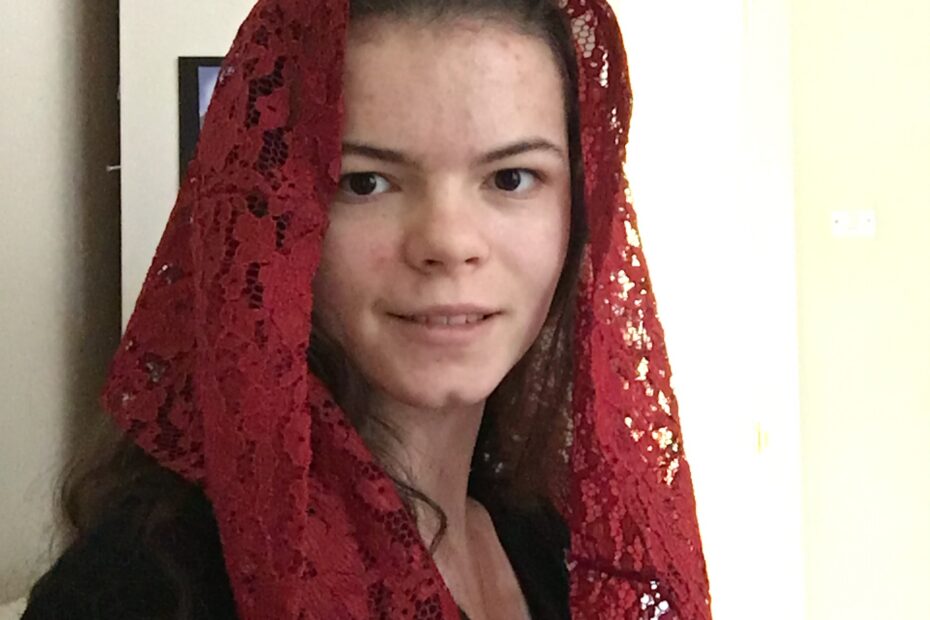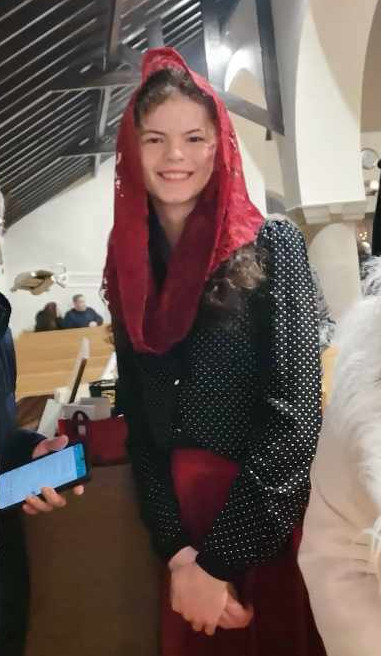For a few weeks now, any kind of lace material has been on my Thriftstore wishlist. Recently I came across an embroidered black lace mini-dress on the £1 clearance rail, and though I was not quite sure if and how it would work, I brought it home, washed it, and started cutting it u, to remake it into a lace mantilla veil.
But Why Veil? It’s the 21st Century Isn’t It?
Women of many religions still veil today, but in Christianity the practice has largely fallen by the wayside. In my Catholic parish, I am one of only two veiled ladies, and when I started about a year ago, I was the only one. Just to be clear, when I say to veil, I mean when inside a church or chapel and not in everyday life. I’m happy to say that this beautiful tradition is actually making a comeback among the younger generation (including myself). Would it be something for you too? Keep reading!
Veiling is a personal devotion, not a requirement. In the Catholic church, women were supposed to veil at mass from St Paul’s time (1 Cor. 11) till the Code of Canon Law of 1917. After the second Vatican Council in the 1960s, fewer and fewer women veiled, and according to the current Code of Canon Law (1983) the church neither condemns nor requires women to veil. Nevertheless, it’s a beautiful practice steeped in tradition, and it can be a wonderful way to practice devotion. So much for the rules and regulations regarding this issue.
“A woman who veils is like the tabernacle light, signifying the true presence of Christ.”
-unknown
For me, veiling is a way to embrace my femininity, by showing respect to the Blessed Sacrament by covering, instead of, like a man, uncovering my head for worship. This in no way diminishes my dignity, or places me “below men” as some think, but rather accentuates our dignity as women, in no way inferior to that of men but equal and complementary. It also helps to get me into a more prayerful mindset, the veil edges framing my face giving extra privacy, and help keep my gaze from wandering.
Other valid reasons to veil include to imitate the Blessed Virgin Mary, the model of a perfect woman, and for modesty and humility (let’s face it, most of us will be a little vain about our hair, especially if it’s long) so covering it in a beautiful way can be a little sacrifice to make. It’s certainly true for me. In fact, when I see women sitting in front of me, some veiled some unveiled, the veiled heads seem to blend into the church more, thus not side-tracking my attention as much.
How to Start Veiling and How I Started
If you’re going to a Novus Ordo parish, you’re likely not going to find many, if any veiled women there, so you might say to yourself “if I veil I’m going to attract attention or distract others”. If that’s the case, I would suggest to start with a plain veil that blends into your hair color. Most importantly, it’s irrelevant what other people think. Don’t talk about it unless people ask, and don’t look around you to see if other people react. Your choice to veil is between you and God, and other people have no say in the matter. You will see that no one is really going to care anyway.
I actually started my head-covering journey in winter by just “forgetting” to take my beanie off in church. Some women did that anyway, and for me it was a good test of intention, because I didn’t like the way I looked in it, as opposed to a beautiful veil. Then I started just wearing my winter scarf as a sort of hood, and then progressed to a thin dark chiffon scarf I happened to have, until finally now I’m confidently wearing lace, and even experimenting with colors. For more tips on veiling for beginners, read this post.
The most important thing is not to look for other peoples opinion. You’re doing this for God, so don your veil and walk into church, like it’s the most normal thing on earth, without looking for reactions. The less you think about the fact you’re wearing one.
I was a little nervous at first, afraid that our priests would not approve, since I had heard some horror stories about that, but no one paid any attention at all, until our priest during a conversation simply said to me one day that he “approved of the mantilla”. I was very happy, because I no longer had to be afraid of a confrontation. Since the I received some comments here or there, all very sweet, often saying how this reminded them of their home countries etc, and one lady was even inspired to start veiling herself. But for the most part, no one pays any attention whatsoever.
The mantilla is normal for me now, and I forget mine, which did happen, I feel naked and exposed during mass. Even (or especially) when I go to a chapel alone, I make sure to veil in the presence of Christ, because then it is 100% between me and Him, no spectators.
Veil Colors
As far as color goes, the Spanish tradition is white for unmarried, black for married women. As an unmarried girl I personally wear white as my “default color” and sometimes switch it up with colors to match the occasion, such as blue for Marian feasts. Sometimes I simply match the veil to my outfit, it’s really up to you. The only color I would not normally wear is black, except for funerals, on the Feast of Our Lady of Sorrows, in the month of November, which is dedicated to remembering the dead, and on Good Friday.
Transforming the Dress into a Veil
I actually happened to be in need of a black veil, so when I found a cute embroidered lace dress, I knew it was just the thing. First I removed the built-in slip from the dress, which I’ll probably end up wearing on its own. Then I cut off the skirt, which was cut open at the center back. This was the only way to get enough material out of this tiny dress.
There were some more applique flowers on the top, which I carefully cut out and reattached to the veil by hand. There was no need to hem the fabric, since it doesn’t fray, so I left the edge unfinished. I really love the way it turned out, and will be wearing it a lot next November. For funerals the flowers are a little bright, but you can actually wear it inside out for a more toned-down look.
A little later I came across a red lace top, that met the same fate as the dress – it was made into a Christmas infinity veil (see pictures). It cost me £3, very decent price for a mantilla!

